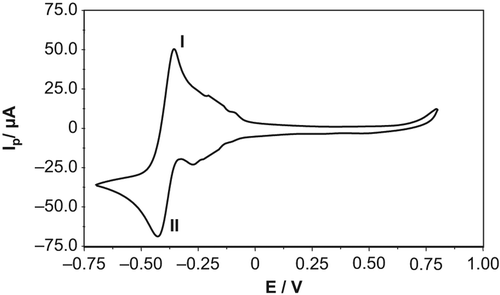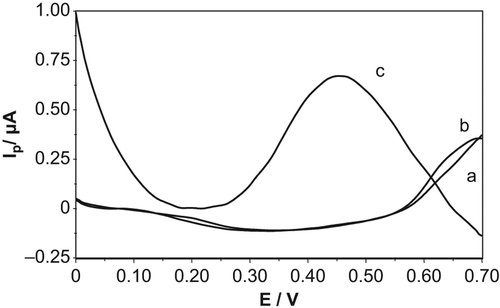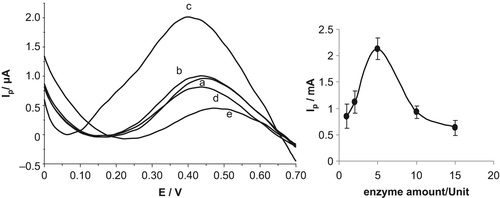Figures & data
Figure 2. Electrodeposition of Pt-NPs onto bare GCPE with cyclic voltammetry in 0.1 M KCl, at a potential ranging between − 0.70 V and + 0.80 V at 50 mV.s− 1 for 50 cycles.

Figure 3. Differential pulse voltammograms of (a) background for GSH-Px(immob)/GCPE, (b) 100 μM GSH/50 μM H2O2 GSH-Px(immob)/GCPE, (c) 100 μM GSH/50 μM H2O2 for Pt-NP-modified GSH-Px(immob)/GCPE. Conditions: 50 mM, pH 7.0 phosphate buffer solution, T = 25°C.

Figure 4. Nyquist plots of the response of the biosensing electrode at different stages in the electrode assembly process: bare GCPE (X); GSH-Px(immob)/GCPE (■) and GSH-Px(immob)/Pt-NP/GCPE (▲). All spectra were recorded in the presence of 1 mM [Fe(CN)6]3−/4− in 0.05 M PBS (pH 7.5), as a redox-active indicator. Frequency range: 104 to 0.01 Hz, 0.05 V amplitude.
![Figure 4. Nyquist plots of the response of the biosensing electrode at different stages in the electrode assembly process: bare GCPE (X); GSH-Px(immob)/GCPE (■) and GSH-Px(immob)/Pt-NP/GCPE (▲). All spectra were recorded in the presence of 1 mM [Fe(CN)6]3−/4− in 0.05 M PBS (pH 7.5), as a redox-active indicator. Frequency range: 104 to 0.01 Hz, 0.05 V amplitude.](/cms/asset/1c983d5e-f168-434e-9617-59ef109ac0ef/ianb_a_1008504_f0004_oc.jpg)
Figure 5. Differential pulse voltammetric responses of 100 μM GSH/50 μM H2O2 on the biosensor response at various amounts of enzyme: (a) 1.0 U, (b) 2.0 U, (c) 5.0 U, (d) 10.0 U, and (e) 15.0 U. Conditions: phosphate buffer solution system (50 mM, pH 7.0), potential range of 0 V and + 0.7 V. Inset: the curve showing the effect of optimum enzyme amount of GSH-Px(immob)/Pt-NP/GCPE.

Figure 6. Differential pulse voltammetric responses of different GSH/H2O2 ratios on the biosensor response; (a) 0.1/1 GSH/H2O2, (b) 0.5/1 GSH/H2O2, (c) 1/1 GSH/H2O2, (d) 2/1 GSH/H2O2, (e) 5/1 GSH/H2O2, and (f) 10/1 GSH/H2O2. Conditions: phosphate buffer solution system (50 mM, pH 7.0), [GSH] = 50.0 μM; potential range of 0 V and + 0.7 V, T = 25°C. Inset: Effect of the GSH/H2O2 ratio in the performance of the GSH biosensor.
![Figure 6. Differential pulse voltammetric responses of different GSH/H2O2 ratios on the biosensor response; (a) 0.1/1 GSH/H2O2, (b) 0.5/1 GSH/H2O2, (c) 1/1 GSH/H2O2, (d) 2/1 GSH/H2O2, (e) 5/1 GSH/H2O2, and (f) 10/1 GSH/H2O2. Conditions: phosphate buffer solution system (50 mM, pH 7.0), [GSH] = 50.0 μM; potential range of 0 V and + 0.7 V, T = 25°C. Inset: Effect of the GSH/H2O2 ratio in the performance of the GSH biosensor.](/cms/asset/aee449d1-f9ab-4d83-b549-d563b02e0729/ianb_a_1008504_f0006_b.gif)
Table I. A comparison of the analytical characteristics of differently modified electrochemical biosensors for the detection of GSH.

